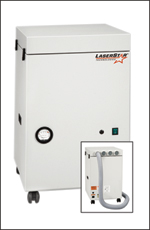Laser Marking and Fume Extraction
“Your Nose…Knows!”
Laser marking systems use light energy to effect a change on a material being processed. In most cases, this change is caused by the rapid heating and cooling of the materials being laser processed. A laser marking system can produce heat energy in energy densities measured in the megawatts/centimeter squared (MW/cm2) in a relatively small heat affected zone (HAZ). At these extreme but highly predictable and controlled temperatures, materials being processed by the laser marking system may melt, burn, bubble, outgas, vaporize, smoke or fume.
A distinction must be made of the by-products of laser processing found in fumes or smoke. Typically there are larger than micron-sized particles of the base material that get caught up in the super heated air vortex and these fall close to the cut area as they cool. Typically called debris, this by-product can be controlled but not always eliminated from the laser process.
Fume extraction is mainly concerned with creating enough vacuum directly around the heat affected area of the material being laser processed to remove those gases created when the material breaks down into a vapor. It also removes any smell or strong odors caused by this out gassing and captures those micron-sized particles so that they can be taken up by the fume extraction system.

Once the fume is captured, it can be processed through a variety of HEPA filters (to remove particle contaminants) and charcoal filters (to remove smells and odors).
In all cases, the experts at LaserStar Technologies Corporation can help you make the selection of a proper fume exhaust system needed for your particular laser marking system or application.
FiberStar’s Laser Marking and Engraving Technology
FiberStar laser markers offer the latest fiber laser engine technology. This state-of-the art technology offers excellent beam quality and results in an extremely long estimated laser engine lifecycle (up to 100,000 hours). All laser marking systems are engineered and assembled in LaserStar’s USA factory in Rhode Island or Florida.
{{cta(‘54708f03-51c1-4d07-88a6-44c8c4c11050′,’justifycenter’)}}




